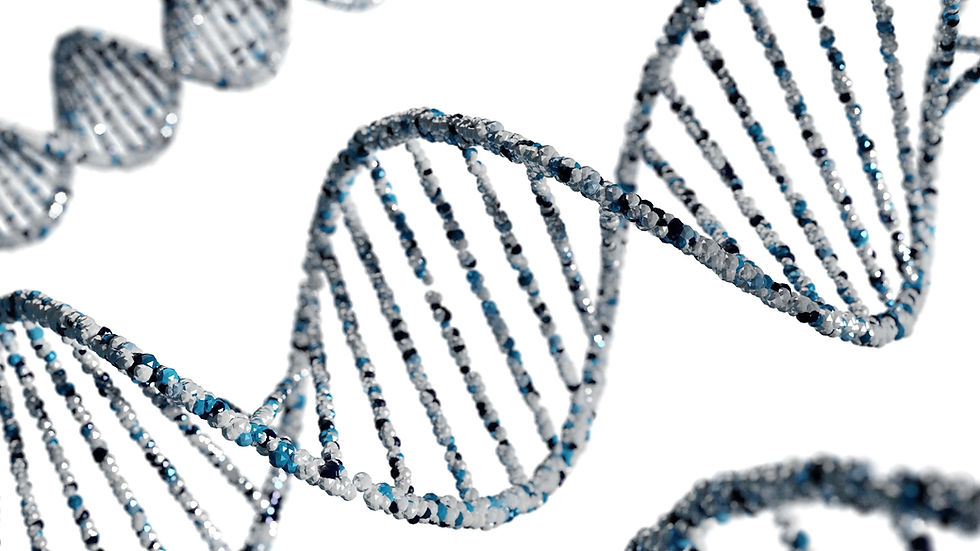What is RNA?
- Pallavi Pilaka-Akella
- Dec 6, 2022
- 4 min read
Updated: Feb 1, 2023
Over the course of the COVID-19 pandemic we have been hearing so much about RNA. We have RNA-based vaccines for the first time in history. Which scientists predict to be much more effective than many previously developed vaccines, so there is a good chance that future vaccines might be RNA-based as well. But what is RNA? Some people have said that RNA is genetic material that can modify your DNA, is that true? Can RNA modify your DNA? In today’s episode we will investigate these questions and many more.
RNA is very similar to DNA. However, RNA is very versatile, it can replicate itself, transmit information on how to create protein, and RNA can create complex 3D structures that play important roles in our cells. In general scientists agree that earliest life forms on Earth were RNA-based organisms, this is called the: RNA World Hypothesis. As organisms adapted to life on Earth RNA molecules were slightly adapted to create DNA which was designated to carry genetic information in a more stable molecule. While RNA was assigned with carrying, deciphering, and regulating genetic blueprints embedded into our DNA.
Over the past few decades people started to realise that RNA is more of an umbrella term, there are many different types of RNA, each with its own structure and purpose! Over the course of this podcast, we will probably cover most of not all the different types of RNA but for today we will focus on messenger RNA (mRNA). mRNA is the type of RNA we all learn in school; this is molecule that takes information from our DNA in the nucleus to the cytoplasm where it is decoded into protein. The process of copying bits of DNA into RNA is called transcription and the process of decoding the mRNA into protein is called translation.

Structurally DNA looks like a twisted ladder, we call this a double helix. Twisting our ladder shaped-DNA creates the most energetically favorable conformation, and allows our cells to compact massive amounts of genetic material into a tiny a microscopic area. Think of a twisty tie, first its wrapped around a grocery bag then the two long ends are twisted together. You could take two really long twisty ties and twist it until it’s so compact it looks like a little bump. Our DNA is packaged in a similar way, its twisted and compacted to store massive amounts of information in very small nucleus. If you unwound your DNA and stretched it across a table and measure it end to end it would measure approximately (182 cm) six feet long. However, a nucleus is about 0.005mm (0.0002 inches) in diameter. This means our cells take genetic material about as tall as a grown man and condense it into an area that is about 10x smaller than a grain of sand!

Unlike the permanent repository established by our DNA, RNA is designed to be created and broken down relatively quickly. This allows our cells to respond to different stimuli, for example, if you cut yourself, your cells would be able to create wound healing proteins and direct them to the affected rea before you bleed out or cause long term damage. mRNA looks like a ladder that has been cut down middle of each rung (called a single helix). RNA can make complex structures that can help it recognize specific proteins or other RNA in its environment.
Volatility of RNA is a critical characteristic without which RNA would not be able to accomplish so much. How is this possible when DNA and RNA are almost identical in their chemical structure? RNA has an extra hydroxyl group (which is just one Oxygen and one Hydrogen atom). This makes all the difference1. This one extra oxygen group makes RNA more unstable than DNA because it makes RNA molecules more susceptible to chemical reactions2. This makes it easier for our cells to dynamically change which proteins, and how much of each protein is being generated at any given point in time. This involves many complex mechanisms that we will discuss throughout this podcast!
In a symphony if one instrument doesn’t perform properly, it sounds off to our ears. We might not be able to tell which instrument is malfunctioning, but we can tell something is off. Imagine attending a symphony with thousands of instruments, each one playing a critical role, slight mishaps in timing or pitch would wreak havoc on entire production. Our cells regulate the timing, production, and amount of mRNA, through complicated mechanisms and fail-safes set in place in case something goes wrong. This orchestra of which gene is being decoded into protein by mRNA is called: Gene Expression.
Summary:
1. DNA looks like a twisted ladder (called double helix) RNA looks like half a ladder (called a single helix).
a. This means RNA can make complex secondary and tertiary structures that help it interact with protein, DNA or other RNA.
2. Messenger RNA (mRNA) carries protein blueprints from the DNA to the cytoplasm where it is decoded, and the relevant protein is made
3. RNA has an additional hydroxyl group which make RNA less stable than DNA.
a. Our cells can regulate which proteins are being generated and in what quantity
4. Gene Expression: refers to which genes are being expressed (or turned “on”) and which are turned “off”.
Given that mRNA is the engineer that decodes protein blueprints, what role does it play in our cells? Can we harness it for potential therapies? The short answer is that mRNA plays a critical role in everything from how we sleep (circadian rhythm), to how we eat, breathe, and even plays a critical role during human development! Understanding the nuts and bolts of how RNA functions in our cells could open a whole new frontier for therapies.
Bibliography
wound healing example: https://biomeddermatol.biomedcentral.com/articles/10.1186/s41702-020-0059-6









Comments